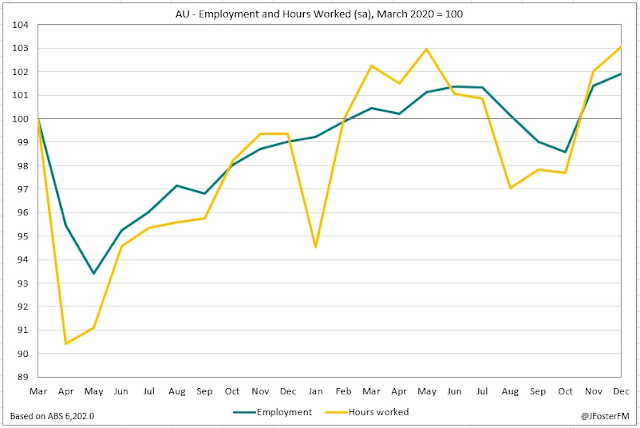The ABS is due to publish the Australian labour force survey for January at 11:30am (AEDT) today. A strong post-Delta lockdown rebound in the labour market came into the headwinds of the Omicron wave in January as illness, isolation requirements and caregiving needs led to high levels of staff absences during what was also the summer holiday period. With underlying demand for labour remaining strong, today's report should tell the story of the disruption to the economy from staff shortages as Omicron surged, with hours worked the key indicator.
As it stands | Labour Force Survey
The post-lockdown rebound in the Australian labour market continued in December as employment lifted by an above consensus 64.8k following November's 366.1k surge. Whereas the part-time segment drove the recovery in employment in the prior month, in December it was full-time employment leading the way with a 41.5k rise as the former added 23.3k.
With eased restrictions and robust economic conditions boosting employment, hours worked continued to rise with a 1% lift in December extending November's 4.5% reopening rebound. Overall, both employment (1.9%) and hours worked (3%) were running well above their pre-pandemic levels and had returned to their levels from prior to the Delta outbreaks.
With the participation rate holding steady at 66.1%, rising employment and hours saw the labour market tighten considerably. The unemployment rate came in from 4.6% to 4.2% — a 13-year low — while underemployment (6.6%) and overall underutilisation in the labour market (10.8%) were also at their lowest levels going back to 2008.
Market expectations | Labour Force Survey
Given the January survey took place during the surge of the Omicron wave, and also coincided with the summer holiday period, there is limited visibility going into today's report. The market median is for a flat outcome on the employment number, though the range of estimates is unusually wide between -60k on the low end and +60k on the high side. Unemployment is expected to remain at 4.2% (range: 4% to 4.4%) but is highly dependent on the movement in the participation rate, which could fall in the circumstances.
What to watch | Labour Force Survey
This is likely to be a volatile report that could throw up some surprises. As with earlier waves of the pandemic, the hours worked measure should be where the main adjustment comes through, reflecting illness, isolation requirements and people staying at home for caregiving needs or to avoid becoming infected. Hours worked are also likely to fall due to summer holidays: recall that in January 2021 hours worked fell by an outsized 4.8% (seasonally adjusted) as a higher-than-usual number of people took time off, delaying their return to work in the new year. Despite the Omicron wave, the underlying strength in labour demand shows no sign of waning; yesterday, the National Skills Commission reported online job vacancies lifted by 4.4% in January to 259k, elevating to 54% above pre-pandemic levels.




